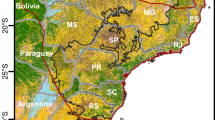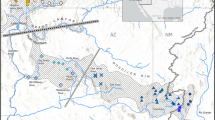Abstract
Spatial genetic patterns can be influenced by a broad range of factors across a landscape. The hypothesis that heterogeneous vegetation and habitat fragmentation rather than water flow influence genetic patterns in two riparian plant species with different niches was tested. Genotyping by sequencing was used to assess the genetic diversity and structure of each species at 12 sites across a river catchment. Generalized dissimilarity modelling examined the relative influence that vegetation type and habitat fragmentation had on patterns of genetic differentiation across the landscape. Restricted gene flow in the widespread species, Callistachys lanceolata, resulted in lower genetic differentiation than that exhibited by Astartea leptophylla, a restricted riparian species with high gene flow. Geographic distance and vegetation type explained the patterns of genetic differentiation in the widespread species, whereas habitat fragmentation and, to a lesser extent, vegetation type explained patterns in the restricted species. Water flow was not found to have significant impacts on patterns of genetic diversity in riparian plant species with restricted and widespread distribution. Impacts of vegetation type on genetic differentiation were most likely due to change in canopy density and associated pollinator communities in the vegetation types across the catchment. Reduced connectivity caused by habitat fragmentation was evident in the restricted riparian species, while reduced connectivity in the widespread species was related to the change of vegetation type between sites. Natural causes of reduced connectivity as well as anthropogenic causes need to be considered in future work to predict persistence and resilience under a changing climate.






Similar content being viewed by others
References
Abbott I (1995) Prodromus of the occurrence and distribution of insect species in the forested part of south-west Western Australia. CALM Science 1:365–464
Aguilar R, Ashworth L, Galetto L, Aizen MA (2006) Plant reproductive susceptibility to habitat fragmentation: review and synthesis through a meta-analysis. Ecol Lett 9:968–980
Antonovics J, Levin DA (1980) The ecological and genetic consequences of density-dependent regulation in plants. Annu Rev Ecol Syst 11:411–452
Beard J, Beeston G, Harvey J, Hopkins A, Shepherd DP (2013) The vegetation of Western Australia at the 1:3,000,000 scale. Conserv Sci West Aust 9:1–152
Bernhardt ES, Palmer M, Allan JD, Alexander G, Barnas K, Brooks S, Carr J, Clayton S, Dahm C, Follstad-Shah J et al (2005) Synthesizing US river restoration efforts. Science 308:636–637
Bradbury PJ, Zhang Z, Kroon DE, Casstevens TM, Ramdoss Y, Buckler ES (2007) TASSEL: software for association mapping of complex traits in diverse samples. Bioinformatics 23:2633–2635
Byrne M, Macdonald B, Francki M (2001) Incorporation of sodium sulfite into extraction protocol minimizes degradation of Acacia DNA. Benchmarks 30:6–8
Catchen J, Hohenlohe PA, Bassham S, Amores A, Cresko WA (2013) Stacks: an analysis tool set for population genomics. Mol Ecol 22:3124–3140
Department of agriculture and food (WA) (2016) Current extent of native vegetation—Western Australia. https://catalogue.data.wa.gov.au/dataset/native-vegetation-extent/resource/a7a4b590-604c-4ebb-806a-0eb0451c1a27
Doyle JJ, Doyle JL (1987) A rapid DNA isolation procedure for small quantities of fresh leaf tissue. Phytochem Bull 19:11–15
Elshire RJ, Glaubitz JC, Sun Q, Poland JA, Kawamoto K, Buckler ES, Mitchell SE (2011) A robust, simple genotyping-by-sequencing (GBS) approach for high diversity species. PLoS One 6:e19379
Elzinga JA, Atlan A, Biere A, Gigord L, Weis AE, Bernasconi G (2007) Time after time: flowering phenology and biotic interactions. Trends Ecol Evol 22:432–439
Evanno G, Regnaut S, Goudet J (2005) Detecting the number of clusters of individuals using the software STRUCTURE: a simulation study. Mol Ecol 14:2611–2620
Ewers RM, Didham RK (2006) Confounding factors in the detection of species responses to habitat fragmentation. Biol Rev Camb Philos Soc 81:117–142
Gautier M (2015) Genome-wide scan for adaptive divergence and association with population-specific covariates. Genetics 201:1555–1579
Gornall RJ, Hollingsworth PM, Christopher D (1998) Evidence for spatial structure and directional gene flow in a population of an aquatic plant, Potamogeton coloratus. Heredity 80:414–421
Goudet J, Jombart T (2015) hierfstat: estimation and tests of hierarchical F-statistics. R package version 0.04-22
Hamrick J, Godt M (1996) Effects of life history traits on genetic diversity in plant species. Philos Trans Biol Sci 351:1291–1298
Hamrick JL, Godt MJW, Sherman-Broyles SL (1992) Factors influencing levels of genetic diversity in woody plant species. N For 6:95–124
Hancock CN, Ladd PG, Froend RH (1996) Biodiversity and management of riparian vegetation in Western Australia. For Ecol Manag 85:239–250
Hendry AP, Day T (2005) Population structure attributable to reproductive time: isolation by time and adaptation by time. Mol Ecol 14:901–916
Holmes TP, Bergstrom JC, Huszar E, Kask SB, Orr F (2004) Contingent valuation, net marginal benefits, and the scale of riparian ecosystem restoration. Ecol Econ 49:19–30
Honnay O, Jacquemyn H, Bossuyt B, Hermy M (2005) Forest fragmentation effects on patch occupancy and population viability of herbaceous plant species. N Phytol 166:723–736
Honnay O, Jacquemyn H, Nackaerts K, Breyne P, Van Looy K (2010) Patterns of population genetic diversity in riparian and aquatic plant species along rivers. J Biogeogr 37:1730–1739
Jombart T, Ahmed I (2011) adegenet 1.3-1: new tools for the analysis of genome-wide SNP data. Bioinformatics 27:3070–3071
Jombart T, Devillard S, Dufour A, Pontier D (2008) Revealing cryptic spatial patterns in genetic variability by a new multivariate method. Heredity 101:92–103
Jombart T, Devillard S, Balloux F (2010) Discriminant analysis of principal components: a new method for the analysis of genetically structured populations. BMC Genet 11:94
Jules E, Shahani P (2003) A broader ecological context to habitat fragmentation: why matrix habitat is more important than we thought. J Veg Sci 14:459–464
Kilkenny FF, Galloway LF (2008) Reproductive success in varying light environments: direct and indirect effects of light on plants and pollinators. Oecologia 155:247–255
Kopelman NM, Mayzel J, Jakobsson M, Rosenberg NA, Mayrose I (2015) Clumpak: a program for identifying clustering modes and packaging population structure inferences across K. Mol Ecol Resour 15:1179–1191
Lischer HEL, Excoffier L (2012) PGDSpider: an automated data conversion tool for connecting population genetics and genomics programs. Bioinformatics 28:298–299
Lowry DB, Modliszewski JL, Wright KM, Wu CA, Willis JH (2008) The strength and genetic basis of reproductive isolating barriers in flowering plants. Philos Trans R Soc Lond Ser B Biol Sci 363:3009–3021
Majer JD, Recher HF (1988) Invertebrate communities on Western Australian eucalypts: a comparison of branch clipping and chemical knockdown procedures. Aust J Ecol 13:269–278
Manion G, Lisk M, Ferrier S, Nieto-Lugilde D, Fitzpatrick MC (2016) gdm: Functions for Generalized Dissimilarity Modeling. R package version 1.3.11. https://CRAN.R-project.org/package=gdm
Markwith SH, Scanlon MJ (2007) Multiscale analysis of Hymenocallis coronaria (Ameryllidaceae) genetic diversity, genetic structure, and gene movement under the influence of unidirectional steam flow. Am J Bot 94:151–160
Millar CI, Stephenson NL, Stephens SL (2007) Climate change and forest of the future: managing in the face of uncertanity. Ecol Appl 17:2145–2151
Petrone KC, Hughes JD, Van Niel TG, Silberstein RP (2010) Streamflow decline in southwestern Australia, 1950–2008. Geophys Res Lett 37:1–7
Pollux BJA, Luteijn A, Van Groenendael JM, Ouborg NJ (2009) Gene flow and genetic structure of the aquatic macrophyte Sparganium emersum in a linear unidirectional river. Freshw Biol 54:64–76
Pritchard JK, Stephens M, Donnelly P (2000) Inference of population structure using multilocus genotype data. Genetics 155:945–959
Prober SM, Byrne M, McLean EH, Steane DA, Potts BM, Vaillancourt RE, Stock WD (2015) Climate-adjusted provenancing: a strategy for climate-resilient ecological restoration. Front Ecol Evol 3:1–5
Qgis Development Team (2016) Qgis geographic information system. Open Source Geospatial Foundation Project. http://qgis.osgeo.org
R Core Team (2016) R: a language and environment for statistical computing. R Foundation for Statistical Computing, Vienna, Austria. http://www.R-project.org/
Ritland K (1989) Genetic differentiation, diversity, and inbreeding in the mountain monkey flower (Mimulus caespitosus) of the Washington cascades. Can J Bot 67:2017–2024
Rousset F (2008) GENEPOP’007: a complete re-implementation of the GENEPOP software for Windows and Linux. Mol Ecol Resour 8:103–106
Rye BL (2013) A revision of the south-western Australian genus Astartea (Myrtaceae: Chamelaucieae). Nuytsia 23:189–269
Seavy NE, Gardali T, Golet GH, Griggs FT, Howell CA, Kelsey R, Small SL, Viers JH, Weigand JF (2009) Why climate change makes riparian restoration more important than ever: recommendations for practice and research. Ecol Restor 27:330–338
Wheeler J, Marchant N, Lewington M (2002) Flora of the South West, Bunbury, Augusta, Denmark, vol 2. Australian Biological Resources Study, Canberra
Wright S (1943) Isolation by distance. Genetics 28:114–138
Wubs ERJ, Fraaije RGA, de Groot GA, Erkens RHJ, Garssen AG, Kleyheeg E, Raven BM, Soons MB (2016) Going against the flow: a case for upstream dispersal and detection of uncommon dispersal events. Freshw Biol 61:580–595
Yan J, Zhu M, Liu W, Xu Q, Zhu C, Li J, Sang T (2016) Genetic variation and bidirectional gene flow in the riparian plant Miscanthus lutarioriparius, across its endemic range: implications for adaptive potential. GCB Bioenergy 8:764–776
Young A, Boyle T, Brown T (1996) The population genetic consequences of habitat fragmentation for plants. Trends Ecol Evol 11:413–418
Acknowledgements
This project was supported by the Australian Government’s Biodiversity Fund. A special thanks to Lee Fontanini from Warren Catchments Council who provided extensive assistance with all the aspects of field work. We thank Kathy Dawson and Andy Russell from Warren Catchments Council for assistance with field work and project management. We thank Bill Bennit and Elaine Steele for access to their property. Data analysis was supported by resources provided by the Pawsey Supercomputing Centre with funding from the Australian Government and the Government of Western Australia.
Funding
This study was funded by an Australian Government Biodiversity Fund grant LSP-944784-1088.
Author information
Authors and Affiliations
Contributions
TH and MB conceived and designed the experiments, and wrote the manuscript. TH performed the experiments and analysed the data.
Corresponding author
Ethics declarations
Conflict of interest
The authors declare that they have no conflict of interest.
Additional information
Communicated by Kendi Davies.
Rights and permissions
About this article
Cite this article
Hopley, T., Byrne, M. Connectivity in riparian plants: influence of vegetation type and habitat fragmentation overrides water flow. Oecologia 188, 465–478 (2018). https://doi.org/10.1007/s00442-018-4226-z
Received:
Accepted:
Published:
Issue Date:
DOI: https://doi.org/10.1007/s00442-018-4226-z




